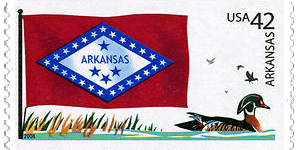 US Postage Stamps
// Philatelic Project
// The Federal States
US Postage Stamps
// Philatelic Project
// The Federal States
Capitals of the Federal States
 US Postage Stamps
// Philatelic Project
// The Federal States
US Postage Stamps
// Philatelic Project
// The Federal States
Capitals of the Federal States

|

|
|
#4278 // June 14, 2008
(self-adhesive coil definitive) Flags of Our Nation Series Arkansas State Flag and wood duck |
Flag of the City of Little Rock,
capital of the State of Arkansas The name of the city derives from a small rock formation on the south bank of the Arkansas River. |
| City, Elevation, Coordinates | County, US Region | Waters |
|
Little Rock, AR
335 ft [102 m] 34°44'10" N 92°19'52" W |
Pulaski County
South |
Arkansas River |
|
Land Area
rounded mi2 [km2] |
Population
(census 2010) |
Population Density
per mi2 [km2] of land area |
| 117 [303] | 193,524 | 1,654 [639] |
| History Timeline | |
|
Central Arkansas was originally inhabited by the
Caddo, Quapaw, Osage, Choctaw, and Cherokee Indian tribes. |
|
| 1722 | French explorer Jean-Baptiste Benard de la Harpe (* 1683, † 1765) landed near a small rock formation on the south bank of the Arkansas River, which he named "la Petite Roche". He built a trading post close to the "Little Rock" within the tribal area of the Quapaw Indians. The little rock was used as a landmark by early river navigation and became a popular and well-known river crossing. |
| 1812 | Fur trapper William Lewis settled close to the little rock. |
| 1821 | Capital of Arkansas Territory |
| 1831 | Little Rock was incorporated as a city |
| 1836 | State Capital of Arkansas |
| 1957 | Nine Afro-American students, present-day known as the Little Rock Nine, attempted to enroll at Little Rock segregated Central High School, which caused massive public protest by the white population. The Arkansas National Guard, directed by Governor Orval Faubus (* 1910, † 1994, in office 1955 - 1967), prevented their first attempt at enrollment. At the time, Arkansas was the third most segregated state in the US (behind Mississippi and Alabama respectively). US President Dwight D. Eisenhower (* 1890, † 1969, in office 1953 - 1961) dispatched federal troops to ensure the students' safety and enforced their right to attend school. |
| 1958 | The four Little Rock's High Schools remained closed for one year by order of Governor Orval Faubus. These 1957/58 events are collectively referred to as the Crisis at Central High. |
![]()
